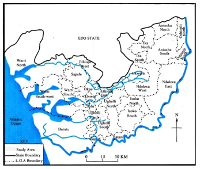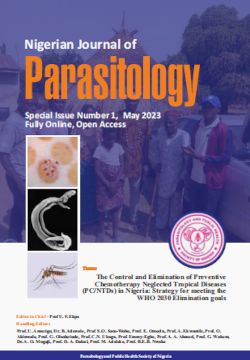Urinary Schistosomiasis among Female Secondary School Students in Ndokwa East Local Government Area in Delta State, Nigeria: Knowledge, Risk Factors and Prevalence
DOI:
https://doi.org/10.4314/njpar.v45i1.24Keywords:
Risk Factors, Knowledge, Prevalence, Urinary SchistosomiasisAbstract
Undiagnosed and untreated cases of urinary schistosomiasis in females usually lead to severe gynaecological complications, collectively known as Female Genital Schistosomiasis. Periodic assessment of schistosomiasis in vulnerable endemic communities will prevent late diagnosis and treatment. This study was conducted to determine the prevalence, knowledge, and risk factors of urinary schistosomiasis among female secondary school students in Ndokwa East Local Government Area, Delta State, Nigeria. A Cross-sectional research design and multi-stage sampling technique were used to select 401 female secondary school students in the Ndokwa East Local Government Area. Participants’ urine samples were obtained and examined for Schistosoma haematobium eggs. A questionnaire was administered to collect information on the knowledge of schistosomiasis and exposure to known schistosomiasis risk factors from each participant. Urinary schistosomiasis was not detected in any of the analysed samples. Most students were uneducated (8% had good knowledge)
regarding the infection. The absence of egg-patent prevalence in the samples may be due to mass administration of praziquantel to control the disease in the LGA. Knowledge about the disease was low. None of the independent variables was a significant predictor of knowledge about urinary schistosomiasis.
References
Adu, D. and Ojo, A. O. (2020). Ethnicity and chronic kidney disease in Africa In Kimmel PL and Rosenberg ME (eds). Chronic Renal Disease (2nd edition).Cambridge Massachusetts, USA: Academic Press pp. 149-166.
World Health Organization (2015).Investing to overcome the global impact of neglected tropical diseases. Geneva,Switzerland: World Health Organization. https://www.who.int/publications-detailredirect/9789241564861
Awosolu, O. B., Shariman, Y. Z., Farah, H. M. T. and Olusi, T. A. (2020). Will Nigerians win the war against urinary schistosomiasis? Prevalence, intensity, risk factors and knowledge assessment among some rural communities in Southwestern Nigeria. Pathogens, 9(2):128.
https://doi.org/10.3390/pathogens9020128.
World Health Organization (2023).Schistosomiasis. Geneva, Switzerland: World Health Organization. https://www.who.int/news-room/factsheets/detail/schistosomiasis. (accessed 10 February 2023).
Steinmann, P., Keiser, J., Bos, R., Tanner, M., and Utzinger, J. (2006). Schistosomiasis and water resources development: systematic review, metaanalysis, and estimates of people at risk. Lancet Infectious Diseases, 6(7):411–425. https://doi.org/10.1016/S1473-3099(06)70521-7.
Orish, V. N., Morhe, E. K. S., Azanu, W., Alhassan, R. K. and Gyapong, M. (2022). The parasitology of female genital schistosomiasis. Current Research in Parasitology and Vector Borne Diseases, 2:100093. https://doi.org/10.1016/j.crpvbd.2022.100093
Siddiqui, A. A. and Siddiqui, S. Z. (2017). Sm-p80-based schistosomiasis vaccine: preparation for human clinical trials. Trends in Parasitology, 33 (3): 194 - 201. https://doi.org/10.1016/j.pt.2016.10.010.
Ezeh, C. O., Onyekwelu, K. C., Akinwale, O. P., Shan, L. and Wei, H. (2019). Urinary schistosomiasis in Nigeria: a 50-year review of prevalence, distribution and disease burden.Parasite, 26:19. https://doi.org/10.1051/parasite/2019020
Shams, M., Khazael, S., Ghasemi, E., Nazari, N., Javanmardi, E., Majidiani, H., et al (2022). Prevalence of schistosomiasis in women: a systematic
review and meta-analysis of recently published literature (2016-2020). Tropical Medicine and Health, 50(12):22.https://doi.org/10.1186/s41182-022-00402-x
Aribodor, O. B., Okaka, C. E., Sam-Wobo, S. O., Okpala, B. C., Aribodor, D. N. and Obikwelu, E. M. (2021). Urinary schistosomiasis and primary evidence of female genital schistosomiasis among pupils in Nsugbe Community, Anambra State, Nigeria. Nigerian Journal of Parasitology, 42(2): 394 – 402. https://doi.org/10.4314/njpar.v42i2.26
Ekpo, U. F., Odeyemi, O. M., Sam-Wobo, S. O., Onunkwor, O. B., Mogaji, H. O., Oluwole, A. S., et al. (2017). Female genital schistosomiasis (FGS) in Ogun State,Nigeria: a pilot survey on genital symptoms and clinical findings. Parasitology Open, 3:e10. https://doi.org/10.1017/pao.2017.11
Bature, E., Auta, I. K., Ibrahim, B. and Auta, I. I. (2022). Female genital schistosomiasis and clinical manifestation in selected communities in Gwagwalada and AMAC, Abuja, Nigeria. American Journal of Science, Engineering and Technology, 7(2): 44-59. https://doi.org/10.11648/j.ajset.20220702.13
Auta, T., Ezra, J. J., Rufai, H. S., Alabi, E.D. and Anthony, E. (2020). Urinary schistosomiasis among vulnerable children in security challenged district of Safana, Katsina State Nigeria. International Journal of Tropical Disease and Health, 41(23):73-81. https://doi.org/10.9734/ijtdh/2020/v41i2330419
Abdulkadin, M. A. and Ahmed, U. A.(2020). Prevalence of schistosomiasis haematobium infection among primary school children aged years in Auyo town (Jigawa State) of Nigeria. Central Asian Journal of Environmental Science and Technology Innovation, 3(1):184-188. https://doi.org/10.22034/CAJESTI.2020.03.07
Abdulkareen, B. O., Habeeeb, K. O., Kazeen, A., Adam, A. O., and Samual, U. U. (2018). Urogenital schistosomiasis among school children and the associated risk factors in selected rural communities of Kwara State, Nigeria. Journal of Tropical Medicine. 2:691318. https://doi.org/10.1155/2018/6913918
Balogun, J. B., Adewale, B., Balogun, S. U., Lawan, A., Haladu, I. S. and Dogara, M. M. (2022). Prevalence and associated risk factors of urinary schistosomiasis among primary school pupils in the Jidawa and Zobiya communities of Jigawa State, Nigeria. Annals of Global Health,88(10):71.
https://doi.org/10.5334/aogh.3704
Babatunde, T. A., Asaolu, S. O. and Sowemimo, O. A. (2013). Urogenital schistosomiasis among pre-school and school aged children in two peri-urban communities in Southwest Nigeria. Journal of Parasitology and Vector Biology, 5(7):96-101. https://doi.org/10.5897/JPVB2013.0113
Ndukwe, Y. E., Obiezue, R. N. N., Aguzie, I. O. N., Anunobi, J. T. and Okafor, F. C. (2019). Mapping of urinary schistosomiasis in Anambra State, Nigeria. Annals of Global Health. 85(1):52. https://doi.org/10.5334/aogh.2540
Folahan, F. F., Edungbola, L. E. and Folahan, J. T. (2021). Prevalence of schistosomiasis among primary school pupils. Journal of Microbiology and Infectious Diseases, 11(1):95-104. https://doi.org/10.5799/jmid.951609
Noriode, R. M., Idiowu, E. T., Otubanjo, O. A. and Mafe, M. A. (2018). Urinary schistosomiasis in school aged children of two rural endemic communities in Edo State, Nigeria. Journal of Infection and Public Health. 11(3): 384 - 88. https://doi.org/10.1016/j.jiph.2017.09.012
Onyekwere, A. M., Rey, O., Nwanchor, M. C., Alo, M., Angora, E. K., Allienne, J. F., et. al. (2022). Prevalence and risk factors associated with urogenital schistosomiasis among primary school children pupils in Nigeria. Parasite Epidemiology and Control, 18:e00255. https://doi.org/10.1016/j.parepi.2022.e00255
Opara, K. N., Akomalafe, R. T.,Udoidung, N. I., Afia, U. U., Yaro, C. A. and Bassey, B. E. (2021). Urogenital schistosomiasis among primary school children in rural communities in Obudu, Southern Nigeria. International Journal of Maternal and Child Health and AIDS. 10(1):70-80.
https://doi.org/10.21106/ijma.407
Muhammad, I. A., Abdullahi, K., Bala, A. Y. and Shinkafi, S. A. (2019). Prevalence of urinary schistosomiasis among primary school pupils in Wamakko local government, Sokoto State, Nigeria. Journal of basic and applied zoology, 80(22). https://doi.org/10.1186/s41936-019-0093-3
Umoh, N. O., Nwamini, C. F., Inyang, N. J., Umo, A. N., Usanga, V. U., Nworie, A. Elom, M. O., and Ukwah, B. N. (2020). Prevalence of urogenital schistosomiasis among primary school children in Ikwo and Ohaukwu communities of Ebonyi State, Nigeria. African journal of laboratory
medicine, 9(1):a812. https://doi.org/10.4102/ajlm.v9i1.812
Yaubu, S. M., Rabasa, A. I., Farouk, A. G., Elechi, H. A., Unmate, I., Ibrahim, B. A., Baba, A. S., Boda, T. A., and Olowu, W. A. (2018). Urinary schistosomiasis in Boko Harem-related internally displaced Nigeria children. Saudi Journal of Kidney Diseases and Transplantation, 29:1395-1402.
https://doi.org/10.4103/1319-2442.248286
Mudassiru, I., Suleiman, A. B., Dibal, D. M., Abdulhamid, Y. and Abba, A. M.(2018). Prevalence of urinary schistosomiasis among school aged children in Bakura local government of Zamfara State Nigeria. Umyu Journal of Microbiology Research, 3(2):7-13. https://doi.org/10.47430/ujmr.1832.002
Ito, E. E. (2019). Hyper-endemicity of urinary schistosomiasis in two communities in lower Niger Delta, Southern Nigeria. Nigerian Journal of Parasitology, 40(1):76-81. https://doi.org/10.4314/njpar.v40i1.12
Igumbor, E. O., Ojo, S. K. S. and OlateruOlagbegi, A. (2010). Detection of urinary schistosomiasis among school age children in Ukwuani L.G.A. of Delta State, Nigeria. The South Pacific Journal of Natural and Applied Sciences, 28: 48 - 51. https://doi.org/10.1071/SP10004
Ekwunife, C. A., Agbor, V. O., Ozumba, A. N., Eneanya, C. I. and Ukaga, C. N. (2009). Prevalence of urinary schistosomiasis in Iyede-Ame community and environ in Ndokwa local government area, Delta State, Nigeria. Nigeria Journal of Parasitology, 30(1): 27 - 31. https://doi.org/10.4314/njpar.v30i1.43986
Ito, E. E. and Egwunyenga, A. O. (2015). Schistosomiasis: the aftermath of 2012 floods in Delta State, Southern Nigeria. International Medical Journal, 22(4):218-223. https://www.researchgate.net/publication/287748526_
Nwabueze, A. A. and Opara, K. N. (2007). Outbreak of urinary schistosomiasis among school in riverine communities in Delta State, Nigeria: impact of road and bridge construction. Journal of Medical Sciences, 7(4):572-578. https://doi.org/10.3923/jms.2007.572.578
World Health Organization. Femalegenital schistosomiasis: a pocket atlas for clinical healthcare professionals. 10 May 2015. Technical document. https://www.who.int/publications-detailredirect/9789241509299.
Downs, J. A., Mguta, C., Kaatano, G. M., Mitchell, K. B., Bang, H., Simplice, H., et al. (2011). Urogenital schistosomiasis in women of reproductive age in Tanzania’s Lake Victoria region. America Journal of Tropical Medicine and Hygi ene ,84(3):364–369. https://doi.org/10.4269/ajtmh.2011.10-0585
Schistosomiasis Control Program. The CarterCentre. http://www.cartercenter.org/health/schistosomiasis/index.html. (accessed 23 December
.
Kramer, C. V., Zhang, F., Sinclair, D. and Olliaro, P. L. (2014). Drugs for treating urinary schistosomiasis. Cochrane Database Systematic Reviews, 2014(8): CD000053. https://doi.org/10.1002/14651858.CD000053.pub3
Ndokwa East: About Ndokwa East local government area. Manpower Nigeria.https://www.manpower.com.ng/places/lga/234/ndokwa-east. (accessed 27 January 2022).
Cochrane W. G. (1963). Sampling techniques, 2nd ed., New York: John Wiley and Sons, Inc.
Ukwandu, N. C. D. and Nworsi, O. P. G. (2004). The perception, beliefs and practices toward genitourinary schistosomiasis by inhabitants of selected endemic areas(Edo/Delta States) in South-Eastern Nigeria. Revista Do Instituto De Medivina Tropical De Sao Paulo, 46:209-216. https://doi.org/10.1590/s0036-46652004000400007
Ayeh-Kumi, P. F., Obeng-Nkrumah, N., Baidoo, D., Teye, J. and Asmah, R. H. 2013). High levels of urinary schistosomiasis among children in Bunuso, a rural community in Ghana: an urgent call for increased surveillance and controlprogams. Journal of Parasitic Diseases, 39(4):613-623.
https://doi.org/10.1007/s12639-013-0411-5
Ndokwa East risks massive crude oil environmental pollution. The Pointer. 10 Nov 2022. https://thepointeronlineng.com/article?artld
=9987&art=Ndokwa_East_Risks_Massive_Crude_Oil_Environmental_Pollution.(accessed 27 January 2022).
Deribew, K., Erko, B., Mereta, S. T., Yewhalaw, D., Zeleke, M. (2022).Assessing potential intermediate host snails of urogenital schistosomiasis, human water contact behaviour and water physicochemical characteristics in Alwero dam reservoir. Ethiopia. Environmental Health Insights, 16:11786302221123576.https://doi.org/10.1177/11786302221123576

Downloads
Published
How to Cite
Issue
Section
License
Copyright (c) 2024 Nigerian Journal of Parasitology

This work is licensed under a Creative Commons Attribution-NonCommercial-NoDerivatives 4.0 International License.




